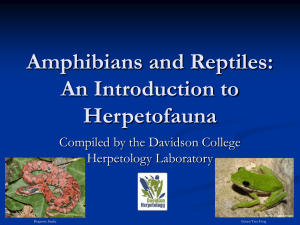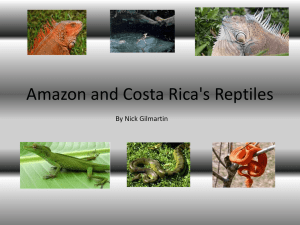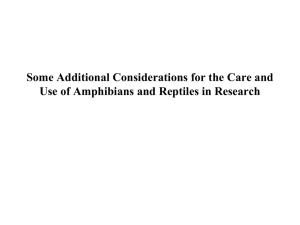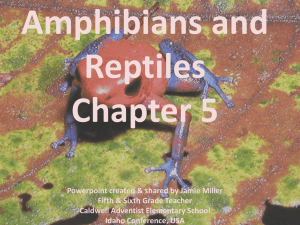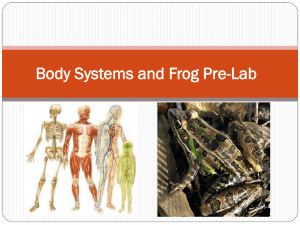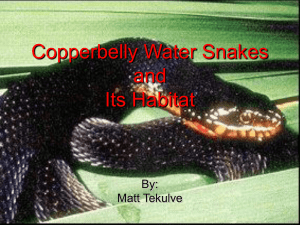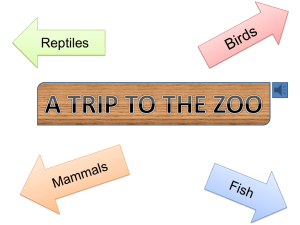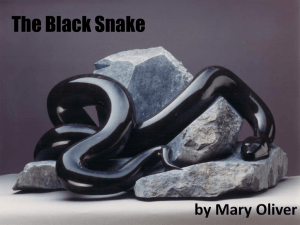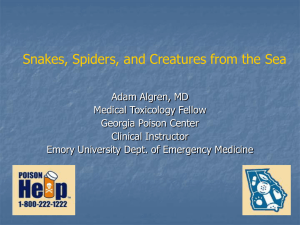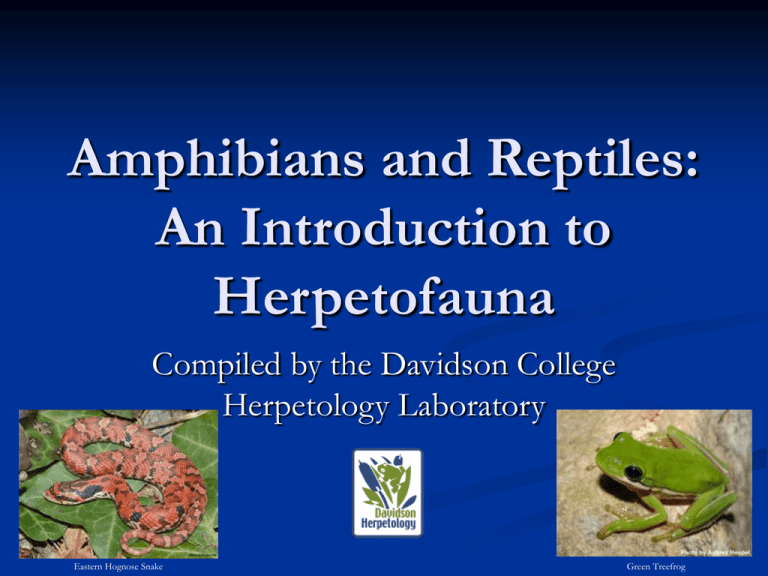
Amphibians and Reptiles:
An Introduction to
Herpetofauna
Compiled by the Davidson College
Herpetology Laboratory
Eastern Hognose Snake
Green Treefrog
Amphibians and Reptiles
Ectothermic
Use outside energy
sources to maintain body
temperature for
metabolism and
regulatory functions
Fence
Lizard
River Cooters
Timber Rattlesnake
Northern
Watersnake
Cryptic
Very difficult to detect
even though they can be
highly abundant
Timber Rattlesnake
Eastern Diamondback
Rattlesnake
Tetrapods
Snakes have evolutionarily
lost their legs
Humans evolved from
one of the same ancestors
of extant reptiles
Non-Tetrapod
Vertebrates
Frogs
Salamanders
Caecilians
Reptiles
Birds
Mammals
Eastern Diamondback Rattlesnake
Adapted from the WhoZoo
Amphibians and Reptiles
Very important to the ecosystem
Prey and Predator
Prey item for animals including
raccoons, opossums, and birds
Prey upon insects, mice, and rats
Bio-indicator
Green Salamander
An animal that can indicate the
health of an environment by its
population structure and abundance
Ringneck Snake
Spring Salamander
Eastern Spadefood Toad
Green Anole
Amphibians
88 Species in North Carolina
Highest salamander diversity
in the world!
Huge Biomass
Biomass: Total weight of all
amphibians in an area
One isolated wetland
produced 3 tons of
amphibians
Spotted Salamander
Three-Lined Salamander
Southern Leopard Frog
Amphibian Characteristics
Permeable skin
Good olfaction
Permeable: Allows the transfer of
oxygen and carbon dioxide to allow
respiration
Can allow the uptake of chemicals
in the environment
Green Frog
Olfaction: Sense of smell
Prey upon:
Insects, other amphibians, anything
small enough to fit into their
mouths, even mice
Spring Salamander
Frogs
Tadpoles lose tails and grow legs as they
metamorphose
True Frogs
Rana
Tree Frogs
Hyla
Toe pads
Southern Leopard Frog
Bull Frog
Spring Peeper
Upland Chorus Frog
Green Tree Frog
Grey Tree Frog
Toads
Similar to frogs
Tadpoles lose tail and grow legs
as they metamorphose into adults
Less dependent upon water than
frogs
Have warty skin
Paratoid Glands:
American Toad
Glands behind the eye that secrete
toxin
Fowler’s Toad
Salamanders
Plethodontids: No lungs
Spring Salamander
Ambystomatids: Lungs
Obligate, aerobic respiration through the
skin
Facultative, aerobic respiration through
the skin
Hellbenders
Grow to 2 feet in the USA, but up to 5
feet in Japan
Hidden gills
Marbled Salamander
Photo by Kristen Cecala
Hellbender
Amphibian Breeding Locations
Streams
Wetlands
Adults utilize upland habitat for feeding
Use stream for breeding, larval period, and
occasional foraging
Spring Salamander Larva
Adults live and feed in upland habitat
Return to wetlands to breed and undergo larval
periods
Terrestrial
Adults never require water for reproduction
No larval stage
Utilize moisture under logs and leaf litter
Redback Salamander
Caecilians
Live in the tropics
Leg-less and blind
Look very similar to a worm
Caecilians
Amphibian Life Cycle
Upland Chorus Frog
Frog eggs
Pine Woods Tree Frog Tadpole
Spring Peeper calling
Cricket Frog
Spring Peeper
Tadpole/Metamorph
Amphibian Defense Mechanisms
American Toad
Toxin in skin
Toads and Newts
Producing large numbers of
offspring
Producing noisy squawks
when attacked
Red-Spotted Newt
Green Frog Tadpole
Reptiles
70 species in North Carolina from 4 groups
Antarctica the only continent without reptiles
Snakes have no legs, but still tetrapods
Evolutionary loss of legs
Boas still maintain a pelvic girdle
Copperhead
American
Alligator
Broadhead Skink
Eastern Painted Turtle
Reptiles
First vertebrates to become independent of
water for reproduction
Some reptiles have reverted to aquatic lifestyles,
but still reproduce without water
Sea Snakes
Swamp Snake
Snapping Turtle
Sea Turtles
Black Swamp Snake
Snapping Turtle
Reptiles
Ectothermic
Maintain a constant
temperature range
Maintained by
basking, movement,
and shivering
Brummation =
hibernation
Yellowbelly Slider
Crocodilians
American Alligator
Osteoderms
Temperature Sex Determination
Sex of offspring determined by the temperature at
which eggs are incubated
American Alligators
Turtles
Temperature sex determination
Vertebrae integrated into shell
No teeth: Beak similar to a bird
Omnivorous
3 habitats
Marine
Freshwater
Terrestrial
Eastern Painted Turtle
Loggerhead Sea Turtle
Box Turtle
Snapping Turtle
Squamata
Snakes and lizards
Jacobson’s organ
Olfactory organ
Tongue flicks out of the mouth and moves
chemicals in the air to the organ
Extremely movable jaw
Green Anole
Rough Green Snake
Scarlet Kingsnake
Eastern Diamondback
Rattlesnake
Lizards
Extremely variable and diverse
Many endemic species
Leg-less Lizards
Five-lined Skink
Glass Lizards or Jointed Snakes
Lizards have eyelids and ear
holes that snakes do not
Slender Glass Lizard
Fence Lizard
Ground Skink
Snakes
37 species in North
Carolina
6 venomous species
Eastern Diamondback Rattlesnake - venomous
Scarlet Kingsnake –
non-venomous
Copperhead, Cottonmouth,
Coral Snake, Timber
Rattlesnake, Eastern
Diamondback Rattlesnake,
and Pigmy Rattlesnake
Most species are nonvenomous
Ringneck Snake – non-venomous
Black Rat Snake – non-venomous
Snakes
All lack legs
Lack ear openings
Hear vibrations through the
ground
Eastern Hognose
Snake
Shed their skin to grow
Either lay eggs or give birth to
live young
Black Racer
Redbelly Watersnake
Ringneck Snake
Coachwhip
Snake Feeding
Entirely carnivorous
Swallow prey whole
Can eat prey much larger than
themselves
Some use venom to immobilize prey
Some constrict their prey
Some actively forage for prey
Some sit and wait for prey to
approach them
Eastern Diamondback Rattlesnake eating a Cottontail
Rabbit
Scarlet Kingsnake eating a Green Anole
Snake Defense Mechanisms
Crypsis: Staying camouflaged
When detected:
Flee, musk, gape, rattle
When these do not work, snakes may
strike
This occurs only when a snake feels
threatened and has no other option to
protect itself
Cottonmouth
Eastern Diamondback Rattlesnake
Eastern Hognose Snake
Brown Watersnake
Conservation
Many amphibians are in
decline
32% of amphibians
endangered versus 12% of
birds or 23% of mammals
43% of amphibian
populations are declining
Few populations are known
to be increasing
Grey Tree Frog
Red Salamander
Bog Turtle
Eastern Kingsnake
Causes of Decline
Habitat destruction
Disease
Pollution
Over-exploitation
Climate change
Invasive species
How many are human caused?
What can you do?
Enjoy finding and observing
amphibians and reptiles
Don’t keep wild amphibians and
reptiles as pets
Don’t kill snakes
Make sure you know a poisonous
species looks like before handling
snakes, and NEVER touch or threaten
a poisonous snake
Don’t release any amphibian or reptile
pet into the wild
Questions?
Corn Snake

